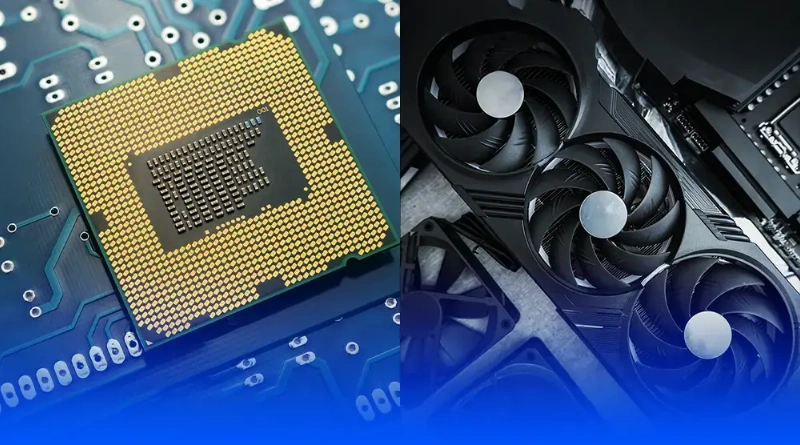1. Introduction: Why the Right CPU/GPU Pairing Matters in Computer Science
In today’s rapidly evolving field of computer science, the right hardware setup isn’t just a luxury—it’s an absolute necessity. Whether you’re training a complex machine learning model, processing massive datasets, developing sophisticated software, or running intricate simulations, your computer’s processing power directly impacts your productivity, research capabilities, and ultimately, your success.
At the heart of any powerful computer science setup are two critical components: the Central Processing Unit (CPU) and the Graphics Processing Unit (GPU). Think of the CPU as the brain of your operation—it’s a versatile generalist that handles a wide variety of tasks, from running your operating system to managing applications and logic operations. The GPU, on the other hand, is the specialized powerhouse—a computational workhorse designed to perform thousands of parallel operations simultaneously, making it indispensable for AI training, scientific computing, and complex visualizations.
The right combination of these components can dramatically accelerate your research, streamline your development workflow, and enhance your learning experience. A well-balanced system eliminates frustrating bottlenecks that can slow down compilations, delay model training, or hinder simulations. However, even the most powerful workstation has its limits. Many computer science projects eventually outgrow a single machine’s capabilities, especially when working with large language models or massive datasets. This is where scalable GPU solutions like WhaleFlux become invaluable, providing seamless access to additional computational resources when your projects demand more power than your personal workstation can deliver.
2. Key Principles for Choosing Your Computer Science CPU/GPU Combo
Selecting the right hardware isn’t about buying the most expensive components—it’s about creating a balanced system where each part complements the others without creating bottlenecks. A common mistake is pairing a powerful GPU with an underpowered CPU, or vice versa, resulting in one component waiting on the other and wasting valuable computational resources.
CPU Selection Criteria: The Brain of Your Operation
When choosing a CPU for computer science work, you need to consider several key factors:
Core Count vs. Clock Speed
This is a crucial balancing act. A higher core count (e.g., 16, 24, or even more cores) benefits tasks that can be parallelized, such as compiling large codebases, running multiple virtual machines, or processing data across multiple threads. On the other hand, a higher clock speed (measured in GHz) improves performance for single-threaded applications and certain development tasks. For most computer science workloads, leaning toward more cores provides better long-term value.
PCIe Lane Support
This technical specification becomes critically important if you plan to use multiple GPUs or high-speed NVMe storage drives. More PCIe lanes allow your CPU to communicate with more devices simultaneously without creating bottlenecks. For multi-GPU setups, adequate PCIe lanes are essential for maintaining optimal performance across all your graphics cards.
GPU Selection Criteria: The Computational Workhorse
Choosing the right GPU requires careful consideration of your specific computational needs:
VRAM Capacity
For AI and machine learning work, Video Random Access Memory (VRAM) is often the most important factor. The size of your GPU’s VRAM determines how large of a dataset or model you can work with. Insufficient VRAM can prevent you from training sophisticated models or force you to use less optimal workarounds. As a general rule, more VRAM is better for computational tasks.
Architectural Features
Modern NVIDIA GPUs include specialized cores designed for specific tasks. Tensor Cores dramatically accelerate AI and machine learning operations, while RT Cores enhance performance for ray tracing and certain types of simulations. Understanding these architectural advantages helps you select a GPU that’s optimized for your particular field of study or work.
The “best” CPU and GPU combination ultimately depends on your primary focus area within computer science. There’s no one-size-fits-all solution, which is why we’ve identified three distinct combinations tailored to different specializations and needs.
3. The Best CPU and GPU Combos for Key Computer Science Fields
Combo 1: The AI Research & HPC Powerhouse
If your work involves training large language models, conducting advanced AI research, or running complex scientific simulations, you need uncompromising computational power.
CPU Recommendation
Processors like the AMD Ryzen Threadripper PRO series are ideal for these demanding tasks. With core counts reaching up to 96 cores in some models, these CPUs can handle massive parallelization across multiple GPUs and manage enormous datasets efficiently. Their extensive PCIe lane support (up to 128 lanes) ensures that multiple high-end GPUs can operate at their full potential without bandwidth constraints.
GPU Recommendation
For the most demanding AI and HPC workloads, the NVIDIA H100 or NVIDIA H200 are the gold standards. These data-center-grade GPUs are specifically designed for large-scale model training and scientific computing, featuring specialized tensor cores and massive memory bandwidth that dramatically accelerate training times and enable work with exceptionally large models.
Ideal For
Researchers and professionals training transformer-based models, working with billion-parameter neural networks, or conducting advanced simulations in fields like computational chemistry or physics.
Scaling Up
For enterprise AI teams, managing clusters of these high-end GPUs efficiently is where WhaleFlux provides tremendous value. WhaleFlux intelligently orchestrates workloads across multiple H100 or H200 GPUs, ensuring optimal utilization and significantly reducing the time-to-insight for large-scale research projects.
Combo 2: The Data Science & Development Workstation
This balanced configuration suits professionals and advanced students working with substantial datasets, developing GPU-accelerated applications, or conducting mid-range machine learning experiments.
CPU Recommendation
A balanced high-performance CPU like the Intel Core i9 or Xeon W-series provides excellent single-threaded performance for development tasks while offering sufficient cores for parallel processing. These processors strike a good balance between clock speed and core count, making them versatile for diverse computer science workloads.
GPU Recommendation
The NVIDIA A100 serves as an exceptional versatile accelerator for data science and development. With its 40GB or 80GB memory options and robust tensor core performance, it handles mid-range model training, complex data analytics, and software development for GPU-accelerated applications with ease. It represents a sweet spot between professional-grade performance and accessibility.
Ideal For
Data scientists analyzing large datasets, software engineers developing GPU-accelerated applications, and researchers working with medium-scale neural networks.
Team Solution
When multiple team members need access to high-performance computing resources, WhaleFlux enables efficient sharing of A100 GPUs across projects and users. This ensures that valuable hardware resources are fully utilized while providing teams with flexible, on-demand access to computational power exactly when they need it.
Combo 3: The Student & Prototyper Setup
This configuration provides excellent performance for computer science students, hobbyists, and professionals prototyping applications without requiring an enterprise-level budget.
CPU Recommendation
High-performance consumer CPUs like the Intel Core i7/i9 or AMD Ryzen 7/9 series offer remarkable computational power at accessible price points. These processors provide more than enough performance for most coursework, personal projects, and application prototyping.
GPU Recommendation
The NVIDIA RTX 4090 delivers exceptional computational power in a consumer-grade graphics card. With 24GB of VRAM and advanced tensor cores, it’s more than capable of handling most student projects, AI prototyping tasks, and coursework requirements. It represents probably the best price-to-performance ratio for individual computer science enthusiasts.
Ideal For
University students completing coursework and projects, developers prototyping AI applications, and researchers conducting preliminary experiments before scaling to larger systems.
Flexible Power
When student projects or prototyping work requires more temporary computational resources, WhaleFlux offers rental options for additional GPU power. This provides a flexible and cost-effective way to access higher-end resources like the RTX 4090 for specific projects without long-term hardware commitments, with minimum rental periods of one month.
4. Beyond the Workstation: Managing GPU Resources with WhaleFlux
As computer science projects grow in complexity and scale, many researchers and developers encounter the limitations of even the most powerful individual workstations. Managing computational resources across multiple GPUs, whether in a lab setting or across a distributed team, presents significant challenges in utilization optimization, cost management, and access coordination.
This is where WhaleFlux transforms how computer science professionals and teams access and manage GPU resources. WhaleFlux is an intelligent GPU management platform specifically designed to optimize computational workflows for AI and data-intensive applications. It acts as a smart resource orchestrator, ensuring that valuable GPU resources are used efficiently and effectively across projects and teams.
The key benefits of integrating WhaleFlux into your computer science workflow include:
Optimized Utilization of NVIDIA GPUs
WhaleFlux intelligently manages workloads across a range of NVIDIA GPUs, including the H100, H200, A100, and RTX 4090. Its advanced scheduling algorithms ensure that these powerful resources operate at peak efficiency, eliminating idle time and maximizing computational throughput.
Significant Reduction in Cloud Computing Costs
By optimizing GPU utilization and providing transparent resource allocation, WhaleFlux helps organizations and research teams reduce their cloud computing expenses by up to 65%. The platform eliminates the waste associated with underutilized resources and provides cost-control mechanisms that prevent budget overruns.
Faster Deployment and More Stable Performance
For teams working with large language models and other complex AI applications, WhaleFlux streamlines the deployment process and ensures consistent, stable performance. The platform manages resource contention, automatically handles job queuing, and provides the computational consistency required for reproducible research and reliable application development.
WhaleFlux offers flexible access to high-performance NVIDIA GPUs through both purchase and rental arrangements. Understanding that different projects have different needs, the platform provides monthly rental options for teams that require temporary access to additional computational resources, with a minimum rental period of one month to ensure stability and cost-effectiveness for both providers and users.
5. Conclusion: Building Your Optimal Computer Science Setup
The quest for the best CPU and GPU combo for computer science isn’t about finding a single universal answer—it’s about matching your hardware to your specific computational needs, research goals, and budget constraints. The ideal combination for a student learning machine learning fundamentals will understandably differ from what’s needed by a research team training billion-parameter language models.
Throughout this guide, we’ve explored three distinct configurations tailored to different computer science specializations:
- The AI Research & HPC Powerhouse pairs high-core-count CPUs with NVIDIA H100 or H200 GPUs for the most demanding computational challenges.
- The Data Science & Development Workstation combines balanced high-performance CPUs with versatile NVIDIA A100 accelerators for professional data science and software development.
- The Student & Prototyper Setup utilizes accessible consumer-grade CPUs with powerful NVIDIA RTX 4090 graphics cards for learning, prototyping, and personal projects.
As your computational needs evolve and your projects scale beyond what a single workstation can efficiently handle, considering comprehensive solutions like WhaleFlux becomes essential. The platform bridges the gap between individual workstations and large-scale computational infrastructure, providing the management layer that ensures valuable GPU resources are utilized optimally, cost-effectively, and reliably.
Building your optimal computer science setup requires careful evaluation of both your immediate hardware needs and your long-term resource management strategy. By selecting the right CPU and GPU combination for your specific use case and understanding how scalable solutions like WhaleFlux can extend your capabilities, you’re investing in a computational foundation that will support your research, development, and learning for years to come.

